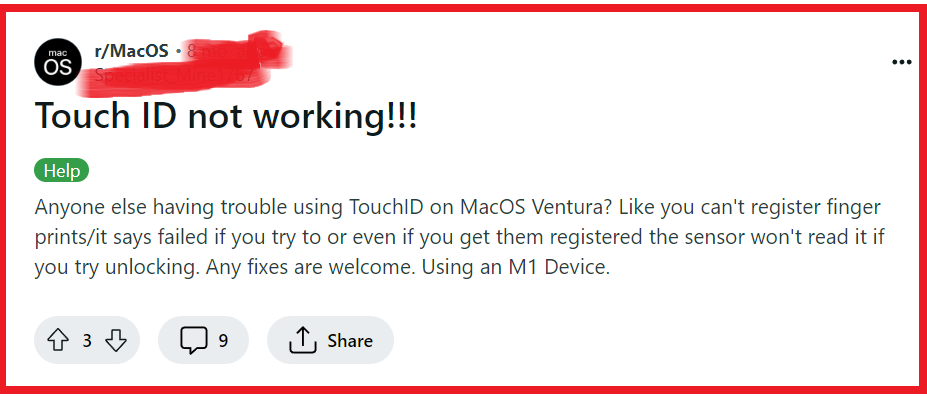Have you recently updated your MacBook to macOS Sonoma and discovered that your Touch ID has suddenly stopped working? If so, you’re not alone.
Many MacBook users have encountered this frustrating issue, but the good news is that there are solutions available to address this problem.
In this blog post, we’ll delve into effective methods to troubleshoot and resolve the Touch ID malfunction on your MacBook running macOS Sonoma.
How To Fix MacBook Touch ID Stopped Working On MacOS Sonoma?

To fix MacBook touch ID stopped working on macOS Sonoma, you can restart your MacBook, update macOS, reset SMC. Additionally, you can reset magic keyboard with touch ID, reset touch ID by power button long press, and verify touch ID settings and automatic login.
1. Restart Your MacBook
Restarting your MacBook can often fix temporary software glitches that may be causing issues with Touch ID, such as the sensor not recognizing your fingerprint or problems arising from an outdated macOS version.
- Click on the Apple menu in the top-left corner of your screen.
- Choose “Restart” from the dropdown menu.

- Wait for your Mac to shut down completely and then start up again.
- Once your MacBook has restarted, test the Touch ID functionality to see if the issue has been resolved.
2. Update MacOS
Ensuring your MacBook is running the latest version of macOS can resolve compatibility issues and software bugs that may be affecting Touch ID functionality.
- Click on the Apple menu in the top-left corner of the screen.

- Select “System Settings” (or “System Preferences” in older macOS versions).
- Choose “Software Update.“

- If an update is available, click “Update Now” to install the latest version.
- After the update, test Touch ID to see if the issue is resolved.
3. Reset SMC (System Management Controller)
Resetting the SMC can resolve issues related to power, battery, and hardware functionality, which may include problems with Touch ID not working correctly after an update.
- Shut down your MacBook.
- For MacBooks with a T2 chip: Press and hold the power button for 10 seconds, then release it. Wait a few seconds, then press the power button to turn on your MacBook.
- For MacBooks without a T2 chip and with a non-removable battery: Press and hold Shift + Control + Option on the left side and the power button at the same time for 10 seconds, then release all keys.
- For MacBooks with a removable battery: Remove the battery, press and hold the power button for 5 seconds, reinsert the battery, and then press the power button to turn on your MacBook.
- After resetting the SMC, check if the Touch ID issue has been resolved.
4. Reset Magic Keyboard With Touch ID
If you’re using a Magic Keyboard with Touch ID and experiencing issues, resetting the keyboard by turning it off and on, then reconnecting it to your Mac using a USB to Lightning cable, can help resolve these issues.
- Turn off your Magic Keyboard by holding down the power button until the light turns off.
- Wait a few moments.
- Turn the keyboard back on by pressing the power button again.
- Connect the Magic Keyboard to your Mac using a USB to Lightning cable.
- Wait for up to 10 seconds as Touch ID may be temporarily unavailable immediately after the keyboard is turned back on.
- Once the keyboard is reconnected and Touch ID is available, test to see if the issue has been resolved.
5. Reset Touch ID By Power Button Long Press
If Touch ID is missing from System Preferences or System Settings, a reset of the Touch ID hardware might be necessary. This can be done by turning off your Mac and performing a long press on the Touch ID button.
- Shut down your Mac completely.
- Press and hold the Touch ID button for 10 seconds, then release the button.
- Wait a few seconds to ensure the system registers the long press.
- Turn your Mac back on by pressing the Touch ID button again.
- Once your Mac has restarted, check System Preferences or System Settings to see if Touch ID has reappeared and is functioning correctly.
6. Verify Touch ID Settings And Automatic Login
To ensure Touch ID is set up correctly on your Mac, you need to check the Touch ID settings and make sure that Automatic login is disabled.
By verifying the Touch ID settings and disabling Automatic login, you can ensure that Touch ID is properly configured to work with your Mac for the services you wish to use it with.
- Click on the Apple menu in the top-left corner of your screen.
- Select “System Preferences” (or “System Settings” on macOS Ventura or later).
- Click on “Touch ID.“
- In the Touch ID preferences, ensure that the checkboxes for the services you want to use with Touch ID (such as unlocking your Mac, Apple Pay, iTunes & App Store, etc.) are selected.
- Go back to the main System Preferences window and select “Users & Groups.“
- Click the lock icon at the bottom left corner to make changes (you may need to enter your password).
- Once unlocked, look for “Login Options” and ensure that “Automatic login” is set to off.
7. Add A Different Fingerprint
If you’re having trouble with Touch ID on your Mac, adding a different fingerprint can sometimes resolve the issue, especially if the current fingerprints are not being recognized properly.
- Choose Apple menu > “System Settings” (or “System Preferences“).
- Click “Touch ID & Password.“

- Click “Add Fingerprint” and follow the on-screen instructions.
